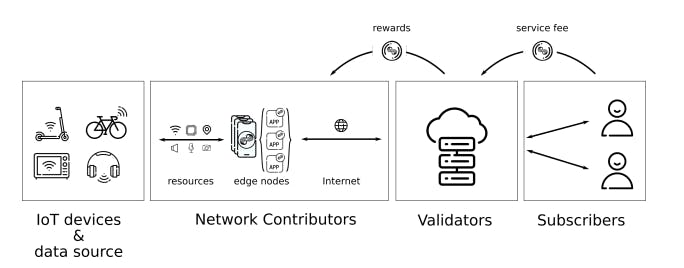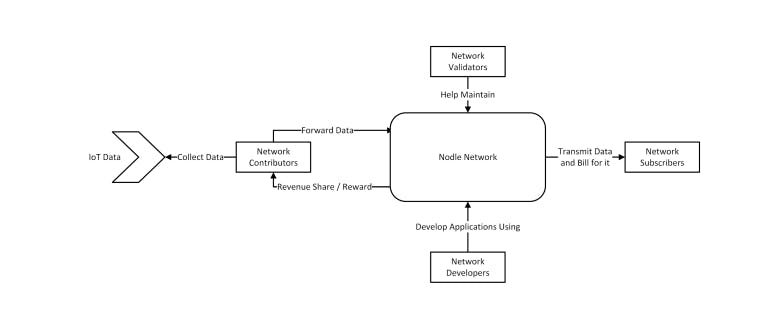A disproportionate amount of attention in Web3 has been focused on currency-related use cases when there are projects being built out that will have profound implications for virtually every industry sector. With that in mind, we’ve taken a closer look at Nodle, a blockchain-based network with implications for the ever-growing Internet of Things (IoT) and a decentralized internet.
What is Nodle?
The Nodle Network provides internet connectivity to IoT devices by taking the innovative approach of crowdsourcing its network through smartphone devices. It’s a hybrid model of distributed internet in combination with blockchain-based micro-payments.

The project was founded by Micha Benoliel and Garrett Kinsmann in 2017 with the ambitious objective of building the largest decentralized network on the planet.
To get there, the project is leveraging the smartphone, an everyday device held by people globally. Individuals can choose to participate in the network as edge nodes using their smartphones. Due to the decentralized nature of the project, there is no filter on participation. Anyone can decide to join the network or leave the network as they see fit.
Nodle has already become one of the world’s largest networks when measured by number of base stations. That’s quite a feat for a project that is otherwise unknown outside of Web3. There are an estimated 6.5 billion smartphone handsets in the wild right now. Another billion are expected to be added within the next 5 years, meaning that there is plenty of potential for a network like Nodle’s to grow further.
Progressive network development
Building a network from scratch is difficult, expensive and oftentimes economically unfeasible. Conventional networks are centralized and struggle to implement a network structure that implicates high-density short range wireless network technology as the cost is prohibitive and deployment is complex.
The IoT needs this type of network structure in order to facilitate data collection from the billions of IoT devices that are likely to be deployed to collect data over the coming years. The current number of connected IoT devices stands at around 14 billion with an expectation that this figure will be doubled within the next 25 years.
The main advantage therefore, is in terms of cost. Nodle is harnessing existing devices and incentivizing their owners to add them to the network. The use of the NODL token also helps to bootstrap the network. In a conventional approach to network build-out, government subsidies and significant venture capital funding is required up front in order to try and get such a network off the ground.
How it works
Bluetooth-enabled smartphones join the Nodle Network and they then effectively become an intrinsic part of the network, providing network coverage and connectivity. A Nodle user installs the Nodle Cash app on their phone (either iOS or android). The application then reaches out to nearby IoT devices on the Nodle Network via low energy Bluetooth.
In effect, smartphone owners are renting out the capabilities of their devices. In return, they are rewarded with Nodle’s native token, NODL. The Nodle app itself acts as a digital wallet for the NODL token.
Those who participate in the network are also free to use other third party wallets including Fearless Wallet, Nova Wallet and the Talisman Wallet while the project recently integrated with hardware wallet Ledger.
 Elements of the Nodle Network : IMG SRC
Elements of the Nodle Network : IMG SRC
The secondary market is supported further with the ability to trade the token through cryptocurrency exchanges such as Kraken, Huobi Global, Gate.io and MEXC Global.
The Nodle Network has the capacity to take advantage of four key things:
A user’s smartphone as a computing device at the ‘edge’ of the network. So as to not over-burden the user’s device, the Nodle Network doesn’t attempt to do too much in the way of processing within the user’s smartphone. However, it has the flexibility to adjust this as handset and network technologies change.
The ability to access various network technologies via the smartphone, including Bluetooth, NFC, WiFi, LTE, etc. The current implementation may be centered on Bluetooth, but this can be adjusted if needed as the network progresses and as network technologies continue to be refined.
Ability to access many sensors within the user’s phone including camera, microphone, accelerometer, gyroscope and GPS. For the most part, the app accesses GPS information right now but the point is that the capacity is there to expand on that as new use cases emerge.
A one-to-one relationship with the device owner.
Individuals using their smartphones as edge nodes are not the only stakeholders in the Nodle Network. It’s also possible that a fleet of nodes can be added to the network, with that fleet being managed by an edge node operator. The network is designed so that edge node operators are made responsible for avoiding fraud and malpractices within their group of nodes.

Nodle Network stakeholders : IMG SRC
Validators settle transactions on the Nodle Chain. They’re connected to both the Polkadot Relay Chain and the Nodle parachain, maintaining a full node on each chain.
The project plans to encourage network developers to design custom applications to run on top of the network. Meanwhile, Nodle Service Providers will provide the last mile in developing an abstract layer to present network utilities in a palatable form to network subscribers.
Network utility
Early utility has been achieved through asset tracking. The French automobile club Roole has partnered with Nodle. In the event of a Roole vehicle being reported as stolen, Nodle-enabled smartphones will be used to locate the vehicle.
In an emailed response to Hashnode, Nodle co-founder Garrett Kinsman stated that "Nodle is a game-changer for insurance and asset tracking as it allows service at a cost point and security previously unavailable".
Bluetooth tags — tiny digital devices which can be connected to devices and equipment — are becoming cheaper. Benoliel foresees a scenario where pretty soon the cost is going to be so low that the deployment of such tags will see exponential growth.
That imminent development will open up all manner of use cases that app developers within the Nodle ecosystem will be able to exploit. Kinsman identifies the opportunity: "Think of anything that can create $1 USD worth of data (the cost of a Bluetooth sticker). We believe that it will become connected."
As the network includes its own native currency, Benoliel also sees scope for the NODL token to be used to pay for things such as mobile data plans. The Nodle co-founder believes that there’s a lot of utility in having a data network in place that is decentralized. He points to the vulnerabilities of a centralized internet infrastructure.
As the network grows, it could also play a part in facilitating the roll out of technologies like 5G in areas where the large telecom companies can’t provide service. Other use cases vary from providing a more savvy way for street performers to get paid to the enablement of smart street furniture in a smart city environment.
Blockchain background & tokenomics
The Nodle Network started out on the Stellar blockchain but relaunched on Polkadot in 2020. This allows it the capacity to connect billions of devices worldwide due to low network transaction costs and an ability to scale.
The network is designed to reward network contributors in NODL tokens, with their contribution being verified via a proof-of-connectivity algorithm.
The project team has tried to design the project’s incentive structure and tokenomics in a way that overcomes the chicken or egg paradox that’s implicated in trying to build such a network. There is no network without network contributors. Contributors need to be incentivized to participate and they need to be in place before there’s utility in the network to be exploited by network subscribers.
In tandem with this approach, Kinsman said that the project is in a phase of network expansion. Network subscribers are being piloted on the service at this early stage. The service is also being trialed with customers who can create their own coverage. He gives the example of a shipping company that uses its own employees as nodes in the network.
 NODL token issuance : IMG SRC
NODL token issuance : IMG SRC
Token issuance rewards early adopters as the smaller the network, the larger the reward. As the network starts to mature, demand rewards play an increasing role, helping in growing the network. Ultimately, the idea is that the network reaches a point where it becomes economically sustainable.
Nodle’s 10 year roadmap
Amara’s law applies where blockchain is concerned:
“Most people overestimate what they can achieve in a year and underestimate what they can achieve in 10 years.”
 Nodle’s 10 year roadmap : IMG SRC
Nodle’s 10 year roadmap : IMG SRC
Blockchain technology has been subject to a number of hype cycles already, where so much is expected of it in a short time frame. Yet the less than glamorous reality is that it will deliver but it’s going to take years to see it fully developed, embedded and utilized. Hence Nodle’s 10 year roadmap.
The team has spent the first 5 years getting the Nodle network up and running. Facing into the next 5 years of that 10 year plan, the focus turns to growing participation on the network, increasing network security and encouraging the development of dApps on the network. The ambition is that as the project progresses, any IoT developer will have tools available to them to write smart apps on the Nodle chain.
Phase 2 of its developmental plan outlines the introduction of staking in an effort to better secure the network, whilst also providing a yield for holders of the NODL token. The addition of a virtual machine within the Nodle SDK during this phase will allow tiny programs to be run at the edge of the network. This will mean that rather than just read device data, complex exchanges can be run and in effect, Nodle becomes a swarm computing network.
Phase 3 will see the establishment of the Nodle DAO in an effort to achieve a greater level of decentralization of the project. It’s anticipated that the final phase of the roadmap will coincide with revenues from network services surpassing those implicated via the token issuance and reward system.
There’s a certain logic to the idea that IoT arrived on the scene before we fully understood what decentralized systems could bring to the table. Projects like Nodle demonstrate how the real power of IoT can be unleashed once the two technologies are combined. On that basis, it’s a project that’s well worth keeping tabs on its progress.

